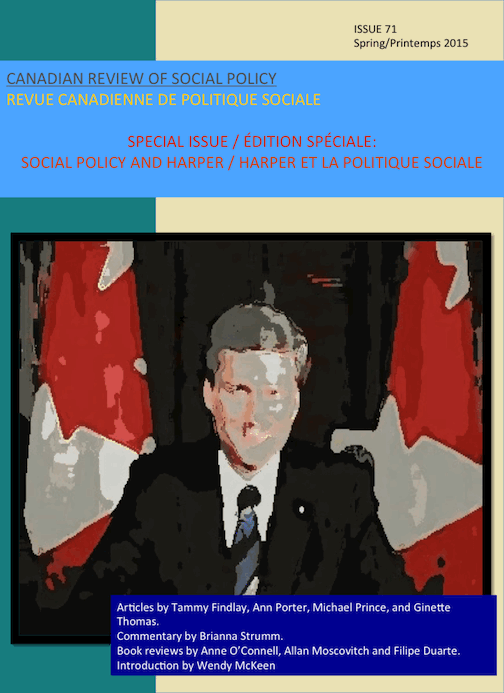The Conservative Government and the Re-emergence of Tuberculosis In First Nations and Inuit Communities
Keywords:
Aboriginal health, tuberculosis, health policyAbstract
In the 1980s, Canada thought that it had beaten tuberculosis. The disease that had reached epidemic proportions during the first half of the twentieth century had started a dramatic and steady decline from the 1950s to the mid-1980s. However, it re-emerged as a public health issue in the 1990s as the rates of tuberculosis started to rise again. Since its return, tuberculosis is affecting the population in a different manner than it did during the period before the 1980s. This time, the rates of tuberculosis are remaining elevated only in First Nations and Inuit communities while in the general population, the rates continue to slowly decline to a level that is approaching zero. The elevated rates of tuberculosis in these communities continue to capture the attention of politicians, and in June 2010, the Parliamentary Standing Committee on Health tabled its Final Report, entitled: The Way Forward: Addressing The Elevated Rates of Tuberculosis Infection In On-Reserve First Nations and Inuit Communities in the House of Commons. In October 2010, the Conservative government tabled its response to this Final Report. This paper examines the government’s lukewarm response to addressing the serious issues that were raised in the Final Report. Le Canada croyait avoir vaincu la tuberculose dans les années 80. La maladie, qui avait connue des proportions épiques dans la première moitié du vingtième siècle, avait entamé une descente dramatique et constante entre les années 1950 à 1980. Malgré cela, la tuberculose est réapparue en tant que problème de santé publique dans les années 1990, pendant lesquelles les taux de tuberculose se sont mis à augmenter de nouveau. Depuis cette reprise, la tuberculose a touché la population de manière différente qu’auparavant. Cette fois-ci, les taux de tuberculose demeurent élevés seulement dans les communautés autochtones et Inuit, alors que dans le reste de la population canadienne, les taux continuent de descendre lentement, à un niveau approchant du zéro. Les taux élevés de tuberculose dans ces communautés continue de capturer l’attention de politiciens, et, en juin 2010 le comité parlementaire permanent de la santé (HESA) a présenté aux communes son rapport final, intitulé : La voie de l’avenir: Comment réagir aux taux élevés de tuberculose dans les réserves des Premières Nations et les collectivités Inuits. En octobre 2010, le gouvernement conservateur a déposé sa réponse à ce rapport final. Cet article examine la réponse tiède du gouvernement fédéral aux graves problèmes dont discute ce rapport final. Mots-Clefs: Santé autochtone; tuberculose; politique sur la santéDownloads
Published
How to Cite
Issue
Section
License
1-The author guarantees that the manuscript is an original work not published elsewhere in print or electronically in whole or in part, except in abstract form, that the author has the full power to make this contribution, and that the manuscript contains no matter libelous or otherwise unlawful or which invades the right of privacy or which infringes any proprietary right.
2-The author guarantees that the manuscript has not been previously published in print or electronically and that if the manuscript contains any tables, figures or images fully reproduced or closely adapted from previously published material, the author must obtain the necessary permission from the author/publisher holding the original copyright prior to publication in CRSP. The author may be required to produce evidence of permission granted to CRSP’s editors.
3-As a condition of publication in CRSP, the author assigns all copyright to CRSP, including but not limited to the right to publish, republish, and otherwise distribute this manuscript in print, electronic, or other formats. As CRSP is a non-profit interdisciplinary scholarly journal, the author will receive no royalty or other monetary compensation for the assignment set forth in this agreement.
For the purpose of full disclosure, CRSP will not normally use the content provided by the author in a commercial venture, but for the purpose of disseminating the author’s content to as many readers as possible. For distribution, third parties engaging in commercial activities may be contracted to distribute the content globally, and such parties may make a profit out of the author’s content in their normal course of business. CRSP will not pay the author or reimburse the author in any form based on such commercial activities because the conduct of such commercial activities is outside the control of CRSP.
Any future reference to or use of this published material by the authors must acknowledge CRSP as the original place of publication.
PERMISSION REQUEST/ARCHIVING
Permission is given to author(s) receiving funding via Tri-Council Agencies, the Canadian Institutes of Health Research (CIHR), the Natural Sciences and Engineering Research Council of Canada (NSERC) and the Social Sciences and Humanities Research Council (SSHRC), to make their publications freely available in an Open Access repository within the stated deadline by the Tri-Council Agencies (12 months following publication). Archiving of publication must be a manuscript copy bearing none of the CRSP headers, footers or any other distinguishing marks. No links to the article on the CRSP website is permitted.
Permission requests from third parties to reproduce articles in part or full in academic/educational publications can be directed to the managing editor of CRSP, and will not be unreasonably denied.

